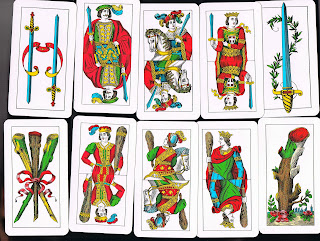Despite its name, the deck is what is known as the "piacentine" pattern. However, the maker's use of the designation is somewhat accurate, as the pattern is used around much of central and northern Italy, a region that encompasses both Piacenza and bologna.
Here is the rather elaborate box in which these cards come in:
Note the differences from the more standard Piacentine pattern -- the ace of swords ( top row, first from right), is straight. In the standard pattern, the sword is curved, and has a cherub perched in it ( see http://anthonylesq.blogspot.sg/search?q=piacentine )
The ace of coins ( top row, first from right), is represented here as an eagle with a blank circle in it's chest. Although this may seem rather odd, in former times, the tax stamp ( to prove that the tax had been paid on this deck) was stamped on the ace of coins. Hence, the makers left a blank space on the ace for this stamp. As the stamp had a coin-like design, when the stamp was impressed, the card looked more like a member of the suit.
However, when the card tax was abolished, there was no longer any need for such a stamp, and the card is left blank.



No comments:
Post a Comment